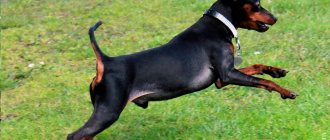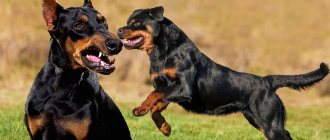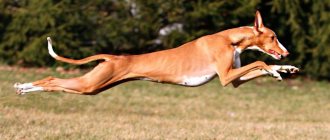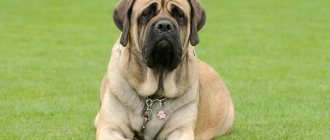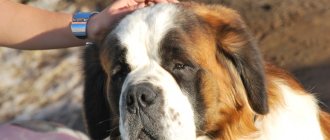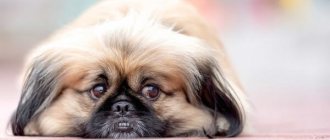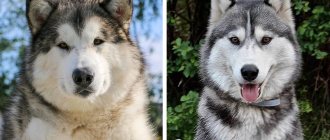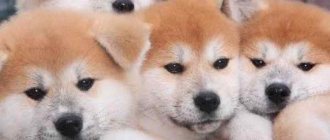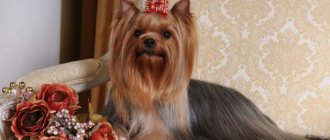Belgian Griffon
Small, playful dogs with a slightly curved forehead, short muzzle and wide skull were bred in Belgium around 1800. Griffons are great companions that require constant mental and physical stimulation. They are somewhat stubborn and picky and cannot tolerate small children of any age. Some males have an increased appetite, so carefully monitor their diet and do not leave food freely available. Clean your thick mustache and drooping beard daily from food debris and any dirt, and comb it. Periodically trim any excess hair that gets into the corners of your eyes to avoid irritation. The optimal number of walks per day is 2-3. After going outside, be sure to wash your paws and undercoat with a special shampoo.
Belgian griffin
Giant Schnauzer
The Giant Schnauzer is a large, powerful animal with a rectangular elongated muzzle, a round black nose, egg-shaped eyes, thick eyebrows, a characteristic neat beard and drooping mustache. This breed is incredibly energetic, restless, and in some situations can become aggressive. Therefore, in a house where there are infants or children under 10 years old, it is not recommended to have such a pet. These dogs need long daily exercise walks with intense exercise lasting 40 minutes or more, regardless of the weather. Very often, Giant Schnauzers are used as yard watchmen. Approximately 2-3 times a week requires thorough cleaning with a stiff bristle brush. Wash your face after every meal. Trim the claws as they grow. A professional haircut is required at least 4 times a year. Organize a proper and balanced diet in consultation with your veterinarian.
Giant Schnauzer
Chinese Crested
The bald dog breed is the Chinese Crested Dog. By the way, among all hairless dogs, this breed is the most popular. And its popularity is a merit not only of today.
So, for example, these dogs were known in China more than 2 thousand years ago. There, hairless Chinese Crested dogs were treated as sacred animals.
But in Europe and other parts of the world the breed became popular at the end of the 19th century, thanks to the fact that one of these dogs was brought to Great Britain. From there the breed spread to other countries, including America. By the way, these dogs are mainly owned by stars, show business representatives and shocking fans. After all, it is simply impossible to remain in the shadows next to such a dog.
But what do we know about the character of these dogs? It turns out that they have natural sensitivity, flexibility, unobtrusiveness, lack of aggressiveness and quick intelligence. They easily find a common language with other animals and can be adopted by families with children.
The center of the universe for these dogs is their owner, separation from whom is very difficult for them to endure. A dog can even get sick in the absence of the main person in its life. She has a hard time with moving, traveling, and loneliness.
Read about other family dog breeds on our website most-beauty.ru. Here you will also find an article about dogs that you can easily travel with!
If, due to circumstances or the nature of your work, you are rarely at home, it is better to refuse representatives of this breed in your home.
She will not remain silent about the fact that the Chinese Crested does not like loneliness. In this case, your neighbors will complain about the constant howling and barking of the dog when she is alone at home, and you will be faced with her little dirty tricks on every corner. So, think about it, are you ready to have an animal that is mega attached to you, a fountain of energy in dog form?
If the difficulties did not frighten you, and you decided, after looking at the photo and description of the breed, to get just such a pet, you should take into account some nuances. Representatives of this breed are not cheap. But, if you do not plan to participate in exhibitions in the future, breed puppies, and you need a dog for your soul, to save some money, you can purchase a crested puppy without documents.
True, there is a great risk of choosing a mestizo rather than a purebred representative of the breed. When choosing a puppy, be sure to pay attention to the condition of the coat (minimal) and skin and whether the photo of the representative of the breed matches the selected puppy. There should be no rashes, redness, or scratching on the animal’s body.
Hairless dogs are very delicate, so in cold weather the Chinese Crested will need clothing for walking. Fortunately, today in any pet store you can buy not only beautiful, but also warm suits for walking.
As for recommendations regarding feeding, breeders recommend avoiding a mixed type of diet, giving preference to either natural food or ready-made premium food.
2
Bearded Collie
The Bearded Collie, Birdie, or Bearded Collie is the oldest English breed, created in Scotland. These dogs have a medium but muscular build, a wide head, slanting coal-black eyes, and thick long hair that hangs slightly from the chin. The height of an adult is about 70 cm, so when feeding, you will need a bowl for bearded dogs on a stand to make it easier for the animal to reach. Be sure to include veal and beef liver in your diet for healthy joints. Birdie is distinguished by intellectual abilities, courage and gentleness of character. She shows kindness, affection and devotion, and is loyal to children and strangers. Approximately 1 hour a day should be devoted to training at specialized sites. Bearded men need periodic haircuts once a month, as well as daily brushing of the coat using hypoallergenic cosmetics.
Collie
Description of the breed
Breeds that are used in fighting fall into a category called fighting dog breeds. There are approximately twenty breeds in the world that take part in this kind of competition. It should be noted that none of the International Canine Organizations recognize the category of fighting dogs. For them, this concept defines the profession, but not the breed of the dog.
The category of fighters has a number of common characteristics: a large head, a well-developed jaw, a massive body and a very menacing bark. A number of Molossians are classified in this category: Alabais, bulldogs, mastiffs, bull terriers and some varieties of Great Danes.
Alabai . A breed endowed with a complex psyche and a unique character. The use of Alabai as fighting dogs in Turkmenistan is a tribute to centuries-old traditions. The only breed that will never finish off an enemy, but will retreat at the first squeal. And, along with this, Alabai is surprisingly gentle and caring towards his own and human children. The main job of this devoted creature is to guard the peace of its owner in any weather and protect his property.
American Bulldog . Takes its roots from the English bulldog. Dogs with a powerful jaw and an iron grip. Initially, they were used for bull baiting, and later in fights against other dogs. Since the fighting qualities of dogs of this breed were not enough, they began to be crossed with various kinds of terriers. As a result of this work, a number of new breeds appeared, but not all of them inherited fighting qualities. And the American Bulldog himself has long forgotten his combat past.
American Pit Bull Terrier . Thanks to the negative media outpouring towards this breed, the pit bull was called the fiend of evil and an idol among fighting dog breeds, becoming the most dangerous creature in the eyes of the public.
In fact, they are one of the most cheerful, loyal and loving breeds on the planet. It simply contains an indomitable desire to please its owner in everything. This is the only breed whose feeling of love for a person is so great that it does not even notice the strong smell of alcohol, although almost all breeds simply cannot stand it.
American Staffordshire Bull Terrier . Another monster of the dog world, so colorfully described by the media. Let us only note that thanks to painstaking selection, the staff has lost its aggression towards living beings.
There are no dangerous breeds! There are very irresponsible owners. If you let upbringing take its course without training, you will definitely end up with a stubborn, unbalanced and disobedient dog. A dog becomes dangerous only with indifferent owners.
Lhasa apso
The Lhasa Apso, or Lhasa, is a Tibetan guard variety with a lush, porous coat covering the entire body, with hanging ears and a tail slightly raised up. Lhasa is independent, capricious, hardy and moderately energetic. Such a pet treats other pets calmly and does not offend small children. Lhasa Apsos require periodic visits to the dentist to remove tartar and plaque. Take your dog to a professional groomer monthly for thorough care of unruly fur. After a walk, bathe the animal, washing away dirt with a soft brush. Walk your pet 2-3 times a day. If you find dirt in the ears, remove it with a cotton swab soaked in a solution of Chlorhexidine or chamomile decoction.
Lhasa apso
Irish Wolfhound
The Irish Wolfhound is a hunting breed first bred by the ancient Celts. Its distinctive features are: a muscular large body, a long elongated head with a pointed muzzle, small ears, soft curly fur of gray, white or black color. This dog is not designed for apartments; it requires a large free space for outdoor games. Spend at least 50 minutes a day walking and exercising. Starting from early puppyhood (from 3 months), train your pet so that in the future he will be kind and socialized. The wolfhound is smart, brave and sensitive, and with proper upbringing, it is friendly to children and other pets. It should be trimmed twice a year. Clean your ears periodically. The diet can include both dry food and natural products.
Irish Wolfhound
Lakeland Terrier
Lakeland Terriers appeared in England in the 17th century. They have a medium body size (up to 40 cm at the withers), curly light brown hair, an elongated muzzle with a curly beard. These pets love to bark loudly, both when threatened and when they are happy. Lakelands treat all family members equally, in some situations they can be amicable, and are easy to train. They need professional training and socialization, daily morning walks, and monthly coat trimming. Every day, wipe your eyes with chamomile infusion and cleanse your ears of wax. Trim the claws as they grow. Feed your pet fresh cottage cheese, boiled sea fish and beef, adding balanced dry mixtures to the menu.
Lakeland Terrier
Polish Lowland Sheepdog
The Polish Lowland Shepherd is the oldest member of the Canidae family, with thick fur, a rounded muzzle and powerful, dense paws. These animals are kind, loyal and friendly, they love active activities and games, and when alone they can become very bored and sad. They are ideal for yard keeping. Due to its voluminous coat, the Polish Shepherd requires careful care: constantly comb and wash your pet, periodically visiting the groomer. Do not overfeed your pet, as this breed is prone to obesity. Create a three-course menu with vitamin and mineral supplements for proper and healthy development.
Polish Lowland Sheepdog
Miniature Schnauzer
The miniature schnauzer is a semi-dwarf graceful dog (height at the withers 35-40 cm) with a shaggy elongated muzzle and black almond-shaped eyes. Its color is varied: from light beige to ash-gray. Average life expectancy is 10-15 years. Kindness, loyalty, tenderness, activity, friendliness are the main character traits inherent in these sweetest creatures. When walking in an unfenced area, try not to let your pet off the leash, otherwise he may run away. The peculiarity of the coat is that it does not shed. But still, a haircut is required every 5-7 weeks. Wash your beard immediately after eating. Shorten your nails 2-3 times a month. Periodically pluck the hairs in the area of the ears and eye sockets. The optimal diet for schnauzers should consist of foods that support vital energy: proteins and carbohydrates. The amount of feeding per day for an adult is 3-4 times.
Miniature Schnauzer
Mexican Hairless Dog Xoloitzcuintle
The ancestors of modern representatives of the breed were bred more than 3 thousand years ago by the Aztec and Mayan tribes in Central America. The dogs received the name Xoloitzcuintle from the name of the native god Xolotl. Then they were cult animals and took part in ritual burials. Hairless dogs were killed and buried along with their deceased owners.
Mexican hairless dog breed Xoloitzcuintle.
The Xolo breed has been formed for centuries through natural selection without human intervention. More than once it found itself on the verge of complete extinction, until in the 50s of the 20th century, cynologists in Mexico and Great Britain approved a revival program. In 1956, Xolos were registered in their homeland, and they became known in other countries.
In Mexico, the Xoloitzcuintle has become a national treasure. There, calm, peaceful animals are attracted to work in nursing homes and hospices. After tactile contact with the skin of dogs, pain in muscles and joints subsides, and gastrointestinal colic is alleviated.
Description
Xoloitzcuintles are well-proportioned, muscular, energetic animals with a high, graceful neck and large, upright ears. Thick, elastic skin is not afraid of bush branches and insect bites. Within the rock, 3 types were formed:
- Miniature ones weigh up to 6 kg and grow up to 25 – 35 cm.
- Medium - with a body weight of 7 - 15 kg, height at withers 36 - 45 cm.
- Standard – weight 16 – 35, height 46 – 60 cm.
In one litter, puppies are born hairless and covered with short, smooth hair. In hairless animals, islands of hair sometimes cover the head, paws, and the top of the tail. Since 2007, both branches are recognized as equal, but two woolly individuals are not mated to each other.
Xolo puppies are hairless and have fur.
The Xoloitzcuintle comes in a variety of colors: solid black, brown, gray, golden, cream and spotted. Dark animals have thicker skin, while light animals have softer and more sensitive skin.
Xolos live 15 – 20 years. They have strong immunity and no serious hereditary diseases. Mexicans are more likely to suffer from dermatitis and food allergies. Fluffy Xoloitzcuintle puppies in nurseries cost up to 10 thousand rubles. The price of naked Xolos starts at 50 thousand, the average is 80 thousand rubles.
Character of the Xoloitzcuintle
Nature has endowed Mexican hairless dogs with a balanced temperament and friendly disposition. Puppies up to 2 years old grow noisy and energetic. Without targeted education, they show willfulness and try to dominate.
Xolos often choose one owner, to whom they completely obey. They treat the rest of the family peacefully and love to play with children. They can easily tolerate short-term loneliness. They don’t chew things, they don’t make a mess in the house. During a long separation from the owner, they often become depressed and refuse to eat.
The Xoloitzcuintle has developed guard qualities. They are distrustful of strangers and may even bite a stranger when trying to pet them. Mexican Hairless dogs are easy to train and show good results in agility and freestyle.
Shih Tzu
The Shih Tzu, or chrysanthemum dog, is a small, neat animal with long, smooth fur. These are affectionate and devoted creatures, indifferent to other pets, preferring the company of their owner. The Shih Tzu's personality is fiery and playful. Correct training will require professional lessons with a trainer, walks on a short leash and learning commands at home. Start lessons from 4 months of birth. To prevent the formation of tangles and knots on the hair, comb the hair several times a day with semi-hard bristles. Bathe no more than once a month. Chrysanthemums are prone to plumpness, so optimize the amount of food - no more than 4 times a day in small portions. Introduce offal (liver, hearts and ventricles), boiled turkey and rabbit meat into your diet.
Shih Tzu
Description of the breed:
The Slovakian Bearded Dog, Rauchbart (Slovakian Wirehaired Pointer) is a vigorous, powerful and unusually persistent dog with increased endurance and versatility. This is both a hunting dog, working equally well in forests and swamps, not at all afraid of frost or sharp thorns on the branches of bushes, and a pet. The animal is protected from natural troubles by thick and rather stiff fur. The high speed with which the dog runs even over rough terrain gives it weight in the eyes of avid hunters. The bearded vulture's target during hunting is usually birds and small rodents such as the hare.
The dog is extremely smart and understanding, smart and intelligent. All this makes her upbringing quite simple. It is preferable to carry out training at home rather than in specialized kennel clubs, since the dog’s learning abilities are better demonstrated in its familiar environment. However, this does not mean at all that a professional trainer cannot be involved in the training process. He will help with his advice on raising and turning the Rauchbart into a highly professional, well-mannered and well-trained animal. However, you should limit yourself only to the advice of the trainer, and the lessons should be conducted by the dog owner himself. She must feel his dominant role, and the owner must suppress the dog’s independence with his own authority. The word “suppress” is a little inappropriate, but it perfectly reflects the essence of what needs to be instilled in the animal using not harsh, but authoritative methods.
The pointer from Slovakia, like all fast hunting dogs, needs space for running, playing, training and relatively high physical activity. That is why it is recommended to keep the Rauchbart outside the city, where it is possible to provide the dog with a free and unconstrained lifestyle. As is the case with most breeds of hunting and guard dogs, Slovakian bearded dogs are increasingly used as companion dogs and are adopted by residents of cities with their high-rise apartment buildings. You should remember about the physical needs of the animal when keeping it in an apartment. The main thing is frequent and long walks. Preferably on a leash. You need to let the dog off as rarely as possible, away from people and other animals, and with full confidence in his obedience and commitment.
According to the rules, it is allowed to take a dog outside in the city only on a short leash and with a muzzle. The exception is puppies under three months of age. Walking dogs without a leash and muzzle is allowed in specially equipped places: on walking and training grounds, in enclosures and dog show venues. In public places, when crossing the roadway and near highways, the dog is not allowed to be let off a short leash. It is prohibited to visit shops and shopping centers, public catering establishments, medical, cultural and educational institutions and other establishments with dogs, except for guide dogs. These do not include specialized facilities for visiting with animals. After a walk in the forest, city park or field, as well as after a hunt (if it is possible to organize it), the wool must be combed every time, freeing it from “natural debris”.
Caring for a bearded dog is not particularly difficult: you just need to comb the coat regularly, paying special attention to the dog’s famous and characteristic beard, from which he received one of his modern names. Brush once a week; frequent washing is not recommended. Despite their apparent unpretentiousness, Slovakian bearded men, like people, prefer to relax in warmth and comfort, and also sleep on soft things. It is best to arrange a place for the dog in the room where its owner is most often.
This animal outwardly gives a rather sloppy impression, which is normal for the breed being described. The appearance of the animal finds few admirers. Perhaps for this reason, the popularity of Rauchbart in the world is low. He is known in Slovakia itself, as well as in the Czech Republic. The population is relatively large in neighboring Poland. In other countries of the Old World, including Russia, dogs of this breed are still outlandish rarities. This pointer is kept and bred mainly only by truly avid hunters.
Skye Terrier
The Skye Terrier is a short, bearded breed (up to 24 cm at the withers), first bred on the island of the same name, located off the coast of Scotland. Distinctive features: dense muscular body, round brown eyes and pointed ears. The color can be anything: from white to black. These pets are suitable for sharing with older children who understand the basics of interacting with an animal. After all, Skye Terriers do not accept disrespect for personal space, assertiveness and annoyingness. They decide for themselves when they are ready to communicate. Walk for at least 30 minutes every day. At home, equip a special bed in the place your pet chooses. Do not have other domestic animals indoors, otherwise they will become a source of prey. Bathe your dog at least 2 times a week using special hypoallergenic shampoos.
Skye Terrier
American Hairless Terrier
A very rare breed with a specific set of external characteristics. Its representative belongs to the group of rat hunters. The American Hairless Terrier is an excellent watchdog, hunter and friend. He was born by chance. Breeders believe that the reason for this was a gene mutation in terrier puppies, whose parents were crossed in the 70s.
When the breeders discovered puppies without fur in the litter, their joy knew no bounds. This dog has a wonderful character. He is sweet and friendly and gets along well with different people. Prefers to be friends with animals rather than compete with them. He can establish a friendly relationship with a cat, but not with a rodent, since this is the main object of his hunt.
Breed standard:
- Height – from 27 to 45 cm.
- Weight – from 5 to 7 kg.
- Rectangular muscular torso.
- Slender long legs.
- Thin hanging tail.
- Triangular large ears sticking up.
- Color – spotted. Most often, the brown body of the animal has beige spots on the back, belly and head.
The American Hairless Terrier is a hairless dog with well-developed hunting instincts. She is energetic, very emotional, active. Hates boredom. I'm ready to devote the whole day to games. Loving and devoted.
Miniature Schnauzer
The Miniature Schnauzer, or Mittel, is an intelligent, but slightly stubborn protector and loyal friend. They choose and recognize only one owner, but treat other family members with respect. Aggression occurs extremely rarely: usually when meeting another dog on the street. Never shout or offend the animal, otherwise the animal will stop trusting you. For harmonious development, take your pet to an equipped area every day. Wash your paws and trim your beard regularly. Miniature schnauzers love swimming, so if possible, organize trips to a specialized pool, and in the summer to a local pond.
Miniature Schnauzer
Representatives of the breed
Akita Inu
Akita Inu is the calling card of the Land of the Rising Sun. This is the most famous breed in Japan and is considered the oldest in the world. They say that the first dog domesticated by man was Akita Inu. 20-35 thousand rubles per puppy
American Akita (Akita Matagi or Large Japanese Dog)
The American Akita is an offshoot of the Akita Inu breed, and the American traces its origins to the ancient Akita Inu dogs. From 700 to 100 US dollars.
American Bulldog
The American Bulldog breed has been known since the 19th century. During its existence, this breed was called “Old English Bulldog”, “Country Bulldog”, etc., but this particular breed of dog is the closest in relationship to English Bulldogs. From 350 to 850 US dollars.
American Pit Bull Terrier
The American Pit Bull Terrier breed has been known for a long time; engravings depicting these dogs date back to the 15-16th century. The breed was originally bred for dog fighting. 200-400 US dollars.
American Staffordshire Terrier
The American Staffordshire Terrier breed has been known for a long time. These dogs appeared as a result of crossing Bull Terriers with Pit Bull Terriers. From 150 to 1000 US dollars
English bulldog
The English Bulldog belongs to the group of mastiff dogs; their ancestors were the fighting dogs of Ancient Rome. These dogs were also used for baiting bulls. In the last century, English Bulldogs have become family pets and companion dogs. From 500 to 1000 US dollars.
Bull Terrier
The first modern bull terriers appeared in Great Britain in 1895. Nowadays, these dogs are popular among breeders around the world; they have proven themselves to be excellent pets, protectors and friends of humans.
Gampr (Armenian gampr, Armenian wolfhound)
This breed is used in a variety of types of work. They rescue and protect, guard livestock and perform service. Acts well as a shepherd and can be an excellent watchman or rescuer.
Cane Corso Italiano
The Cane Corso is considered one of the most ancient representatives of the Mollos (Mastiff-like) group. There are facts indicating that the ancestors of Cane Corso Italiano were ancient Roman fighting mastiffs, which were used at that time as dogs for 15,000 - 20,000 rubles per puppy
Pitbull
Pit bull terrier means fighting bull terrier. Pit bull terriers are often called pit bulls for short. But this is incorrect, since pit bull means fighting bull.
Rottweiler
The breed comes from Germany, from the city of Rottweil, which is located in the south of this country. There is a version that Rottweilers trace their history back to the times of the Roman Empire, where they were fighting and racing dogs. From $300 to $500.
Drathaar
The Drathaar, or wirehaired German pointer, is a type of hunting dog developed in Germany in the late 19th century. Endurance, friendliness and obedience are the main character traits of the animal. German Drahthaars love small children, active games and under no circumstances show aggression towards strangers. A suburban area is ideal for keeping this breed, allowing for constant physical activity for the pet. Basic coat care: bathe twice a week, comb and trim once every 3 months. In the spring and summer, treat the undercoat with antiparasitic compounds, for example, Frontline. Drathaars are very fond of boiled buckwheat or millet cereals, beef and quail eggs.
Drathaar
Peruvian Inca Orchid
Hearing the name, many people want to look at photos of the breed out of curiosity. I wonder what such a dog looks like, which you rarely see in our area. A funny crest, the ability of the animal’s skin to change its color depending on the air temperature - all this turns representatives of the breed into sacred animals. In Peru they are treated like animal deities.
Where did the breed come from? Some experts say that it originated in Africa, while others claim that it was developed in China. Be that as it may, the images of these dogs on ceramic products from the civilization that lived before the Incas indicate that this breed is very ancient.
If you are lucky enough to find such a puppy, consider yourself to have won the Jackpot. These are very gentle and calm dogs that quickly get used to their owner and new family. The dog expresses its joy with a loud ringing bark. Representatives of the breed are devoid of aggression, but they are wary of strangers.
Another feature of dogs is that they prefer to be nocturnal, while during the day they sleep. This point will have to be taken into account, and if you want to rebuild the orchid’s internal clock, you will have to try hard.
Today there are three varieties of this breed:
- Mini (up to 8 kilograms);
- Medium (up to 12 kilograms);
- Maxi (up to 25 kilograms);
There are dogs with minimal fur and completely hairless. By the way, in order to get healthy and viable offspring, it is worth breeding dogs with different coats (hairless and hairless). Breed standards allow hairless dogs to have a tuft and tufted tail.
Albinism, deformed bite, and excessive hairiness are considered serious defects of the breed.
As for caring for these dogs, they need careful and delicate care for their delicate skin. However, you should not bathe them too often, because of the risk of disturbing the pH of the skin. For bathing, you must use special dog products for hairless dog breeds.
Irish Blue Terrier
The Irish Blue Terrier, or Kerry Blue, is an elegant, stately dog with soft curly hair, a funny long beard and bushy eyebrows. Distinctive features: stubbornness, attentiveness, excellent attitude towards children. Be sure to be strict when training, otherwise the Kerry Blue may become willful and show character. Remember the basic rule of communicating with a blue terrier: never shout or raise your hand at the animal. Otherwise, you risk losing full contact with your “true friend.” The coat of these dogs is single-layer, so it practically does not shed. The main thing is to teach your pet to go to the groomer from puppyhood. There are no special instructions regarding catering. The number of feedings is 4 times a day.
Irish Blue Terrier
History of the origin of the Bouvier des Flanders
Perhaps the emergence of the Bouvier breed can be called the most confusing of all stories of canine origins. According to various testimonies, Belgium, France, and the Netherlands are considered the birthplace of this breed. But it would be more correct, apparently, to talk about Flemish soil, on the territory of which all these states are located.
Purebred dogs, as they are understood today, practically did not exist until the 17th century. There were quite a lot of working dogs, and they can even be considered more or less purebred, but to improve working qualities, regular interbreeding was carried out.
The first clubs began to be created by breeders of English Foxhounds, and dog shows became a new fashion in Europe. The first canine communities appeared, and by 1890 the bulk of herding dogs already had their own standards. The dog magazines of that year contain descriptions of an unusual breed of cattle dog living in Flanders. With the help of these animals, cattle were driven to markets and from one pasture to another.
The “duties” of such dogs included monitoring the livestock, they did not allow them to wander, they barked and even bit the lagging and disobedient animals. In their homeland, Bouviers were simply irreplaceable, but outside its borders almost nothing was known about the dog. British writer Maria Rame published The Dog of Flanders in 1872, which became a classic in the USA, England and Japan.
Since initially these dogs were kept by the Dutch-speaking peoples, who gave their four-legged helpers names according to their type and main activity. Therefore, if you translate the first names of the Bouvier, they will sound like “cow shepherd” and “dirty beard”. This is the basis for the version of the origin of the Bouvier from German and Dutch dogs.
The most common theory is that their ancestors were schnauzers, because these dogs were at the peak of their popularity back then. There is also an assumption that French dogs, which were brought to Flemish lands along trade routes, were involved in the appearance of the Bouvier.
According to other hypotheses, Bouvier dogs appeared by crossing the Beauceron and different types of griffins, as well as the result of the selection of English dogs with rough hair, such as the Irish Wolfhound or the Scottish Deerhoud, with shepherd dogs, which was carried out by the monks of the Ter Duinen monastery, where the first kennel was located. Each of these hypotheses may be close to reality, but the truth lies somewhere “in between.” Since Flemish farmers were active in trading and military activities, they had access to a large number of European breeds.
We advise you to read: Doberman Dog Breed
To obtain a universal shepherd dog, they crossed different dogs, as a result of which the Bouvier is a kind of “explosive mixture” of different breeds. In it you can find something from Airedale Terriers, Giant Schnauzers, German Boxers, various Collies, Griffons, Briards, Beaucerons and some other varieties.
The division of Belgium into two regions led to the use of Dutch in Flemish lands and French in Wallonia. Since 1890, the breed has become more in demand in Wallonia, where it was named in the French manner - Bouvier des Flandres (herding dog from Flanders).
The popularity of the French language then contributed to the fact that the name stuck. They made their debut at exhibitions in the Flemish lands in the first decades of the 20th century. And in 1914, the first breed standard was described in Belgium.
Soon after the official recognition of the breed, the First World War broke out. Until that moment, there were at least two variations of the breed. At the time of the German occupation of Belgian territory, only 20 such dogs were recorded. Many dogs became famous during wartime, but none of them managed the Bouvier des Flanders Representatives of this breed performed various functions in the army, they demonstrated courage and intelligence, becoming famous and popular.
But many dogs died at that time. And the destruction of the economy led to the inability to support them. The economic recovery process began in 1920, but the need for cattle dogs disappeared with the development of the railroad. Despite the disappearance of the main occupation for these dogs, the owners still kept these versatile animals. And in 1922 the first breed club was created. In the next decade, the breed became in demand in all countries of Flanders. Over 1000 dogs are registered every year.
Of course, Bouviers also actively participated in World War II; many dogs died in battle. But for Belgium, these years turned out to be so difficult that the breed almost disappeared - there were no more than a hundred dogs. In the 50-60s, the breed was actively developing in America, and in 1980, even the American President Reagan acquired a dog of the Bouvier des Flandres breed. Now in Europe these dogs are involved in various jobs. They serve in the army, police, rescue service, customs and guard various objects.
Affenpinscher
The difficult to train, disheveled Affenpinscher is an old European breed. It began to be started in the mid-18th century. A long beard, drooping ears, short stature (up to 25 cm), a coal-black undercoat, and a high tail are the features that distinguish this dog. Affenpinschers are inquisitive and smart. They guard their own property (for example, toys) with special vigilance, so it will be quite difficult for them to get along in the same apartment with small children. Regularly trim the hairs growing near your eyes. Take daily long walks with outdoor games (running for a stick, frisbee or ball). Trim claws once every 4 weeks. Brush your teeth with a special brush.
Affenpinscher
The most intelligent, beautiful and unusual breeds of bearded dogs were described in this article. Protect, care and protect your pet, and then he will reciprocate your feelings. If you have any controversial issues with the organization of care and nutrition, we recommend that you contact your veterinarian.
